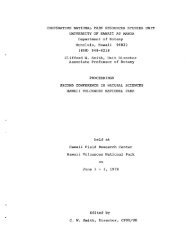american samoa - University of Hawaii at Manoa
american samoa - University of Hawaii at Manoa
american samoa - University of Hawaii at Manoa
Create successful ePaper yourself
Turn your PDF publications into a flip-book with our unique Google optimized e-Paper software.
A modem introduction, n<strong>at</strong>ive to tropical America.<br />
Setchell 502; Garber 830.<br />
Cet~tosteca lappacea (L.) Desv.<br />
sefa<br />
Erect grass with broad leaves and tiny awnless<br />
spikclets in a large panicle. Occasional to common<br />
in shady disturbed places and along forest trails,<br />
reported from near sea level to 650 m elev<strong>at</strong>ion.<br />
Possibly indigenous, or a Polynesian introduction,<br />
ranging from tropical Africa to the Marquesas.<br />
Graeffe s.n.; Setchell 78, 516; Garber 867, 889;<br />
Yuncker 9439; Wisner 161, 162; Long 3046;<br />
Whistler 2974, 3230, 8474, 8599!, 91 8 1.<br />
Chloris barb<strong>at</strong>a (L.) Sw;<br />
[fingergrass]<br />
Erect grass with digit<strong>at</strong>ely arranged panicle branches<br />
<strong>of</strong> awned, purple spikelets. Common in dry<br />
disturbed places, reported only from coastal areas.<br />
A modern introduction, n<strong>at</strong>ive to tropical America.<br />
Setchell 508; Eames T17; Wilder 21; Garber 801;<br />
Christophersen 980; Whistler 901 1 !.<br />
*Chloris radi<strong>at</strong>a (L.) Sw.<br />
Erect grass with digit<strong>at</strong>ely arranged spikes <strong>of</strong> awned,<br />
silvery spikelets. Rare in pastures, reported only<br />
from the lowlands. Perhaps no longer found in<br />
American Samoa. A modern introduction, n<strong>at</strong>ive to<br />
to tropical America. Whistler 305.<br />
*Chrysopogon acicul<strong>at</strong>us (Retz.) Trin.<br />
Low, m<strong>at</strong>-forming grass with awned, purplish spikelets<br />
borne in erect, scapose panicles. Common in<br />
lawns, streambeds, and fernlands, reported only<br />
from the lowlands. A Polynesian introduction,<br />
n<strong>at</strong>ive to the Old World tropics. Setchell 500;<br />
Eames T17; Garber 798; Lamoureux 3077.<br />
Coix lacryma-jobi L.<br />
[Job's tears] sagasaga<br />
Tall, robust grass with large leaves and spikelets th<strong>at</strong><br />
form white to gray, bead-like spikelets. Occasional<br />
to common in wet, disturbed places, reported only<br />
from the lowlands. A Polynesian introduction,<br />
n<strong>at</strong>ive to Asia. Setchell 296; Garber 896; Diefenderfer<br />
23; Christophersen 1207; Whistler 8616!.<br />
"Cynodon dactylon (L.) Pers.<br />
[Bermuda grass]<br />
Prostr<strong>at</strong>e, m<strong>at</strong>-forming grass with erect inflore-<br />
scences usually bearing four digit<strong>at</strong>ely arranged,<br />
spic<strong>at</strong>e branches. Common in lawns and in sunny,<br />
disturbed places, reported only from the lowlands.<br />
A modern introduction, possibly n<strong>at</strong>ive to tropical<br />
Africa. Whistler 3300.<br />
Cyrtococcum oxyphyllum Stapf<br />
Medium-sized grass with lanceol<strong>at</strong>e leaves and<br />
awnless spikelets borne on fine stalks in narrow<br />
panicles. Locally common in shady forest areas and<br />
disturbed places, reported from near sea level to 830<br />
m elev<strong>at</strong>ion. Indigenous or a Polynesian introdu-<br />
ction, ranging from Malaysia to Niue. Christo-<br />
phersen 3559; Whistler 2845, 851 l!, 8939?.<br />
*Cyrtococcum trigonum (Retz.) A. Camus<br />
Small, somewh<strong>at</strong> prostr<strong>at</strong>e grass with pubescent<br />
awnless spikelets in a short, narrow panicle.<br />
Common in lawns and other sunny, disturbed<br />
places, reported from near sea level to 550 m<br />
elev<strong>at</strong>ion. A modern introduction, n<strong>at</strong>ive to<br />
Southeast Asia. Lamoureux 3068; Long 2603;<br />
Whistler 1432.<br />
Dactyloctenium aegyptium (L.) Willd.<br />
Low grass with a short inflorescence stalk bearing<br />
1-5 thick, digit<strong>at</strong>ely arranged branches <strong>of</strong> purplish,<br />
bristly spikelets. Occasional in disturbed dry places,<br />
reported from near sea level to 240 m elev<strong>at</strong>ion. A<br />
modern introduction, n<strong>at</strong>ive to the Old World<br />
tropics. Wisner 26; Whistler 8623!.<br />
Digitaria ciliaris (Retz.) Koel.<br />
Medium-sized to tall grass with multiple whorls <strong>of</strong><br />
digit<strong>at</strong>ely arranged panicle branches bearing awnless<br />
spikelets. Common in plant<strong>at</strong>ions and sunny, disturbed<br />
places, reported from near sea level to 600 m<br />
elev<strong>at</strong>ion. A modem introduction, n<strong>at</strong>ive to Asia.<br />
Whistler 306, 8925!, 9013!.<br />
"Digitaria henryi Rendle<br />
Small grass with spikelets in a short panicle whose<br />
branches do not spread or extend much out <strong>of</strong> the<br />
she<strong>at</strong>h <strong>at</strong> m<strong>at</strong>urity. Uncommon in disturbed places,<br />
reported only in coastal areas. Some authors include
















